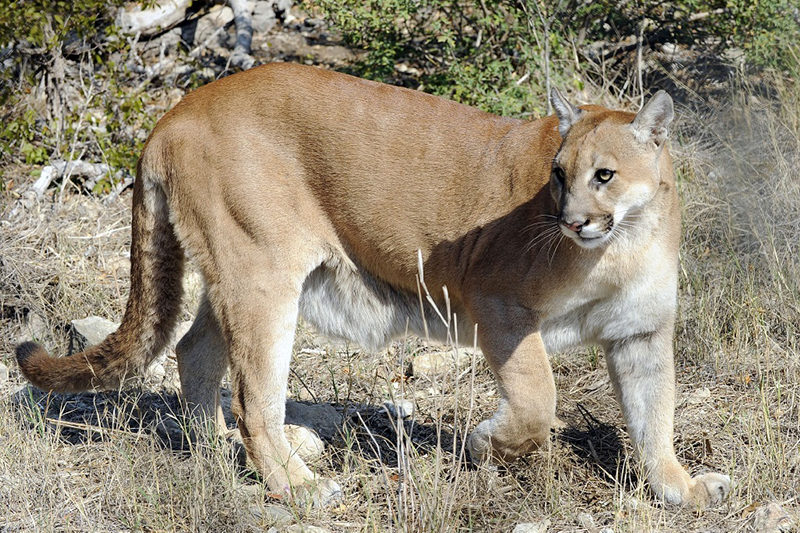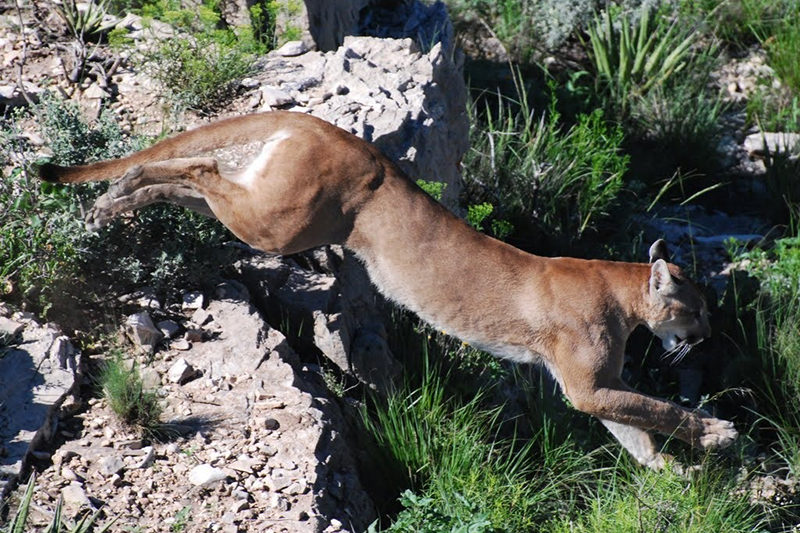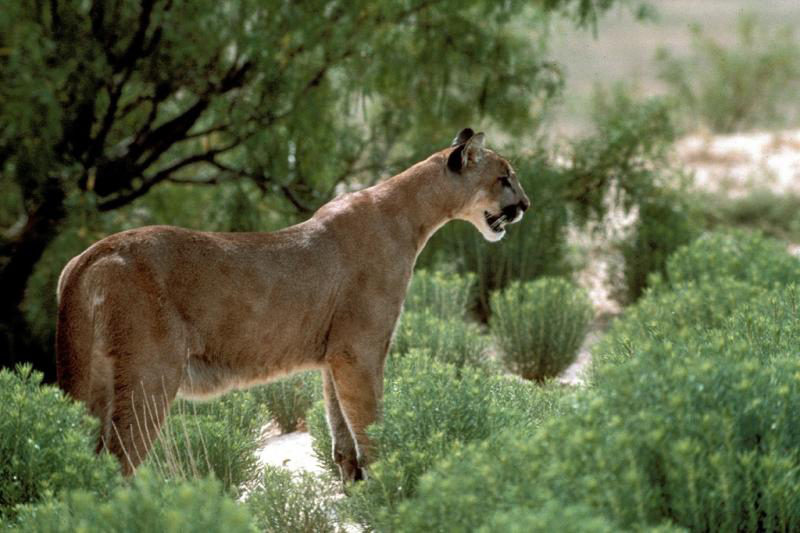Estimating Texas Mountain Lion Population Is Like Herding Cats — Literally
By Kayla Meyertons
Reporting Texas

Photo courtesy Texas Parks & Wildlife Department
A glimmer of a golden tail shoots through the corner of your eye on your drive home. A huff in the middle of the night wakes your sleeping dog. A hike in Big Bend National Park raises the hair on your neck.
Most Texans know that mountain lions lurk in backyards, ranches and national parks across the state, especially in West and South Texas. But what evades biologists and trappers alike is where exactly to find these elusive predators — and how many are out there.
The mountain lion, scientific name Puma concolor, is also known as cougar, puma, panther, painter and catamount. Its range extends from Canada to South America, the widest distribution of any wild cat. However, there are no credible population estimates for Texas for a number of reasons, including their status as a nongame species, the state’s lack of mandatory harvest reporting and lions’ ranges into New Mexico and Mexico.
With black bears, mountain lions are the largest predators remaining in Texas. Wolves, grizzly bears and jaguars have been wiped out. Recent studies have shown lions kill more prey meat than they need, leaving behind free meals for birds, insects and other scavenger critters to feast on. In this sense, they weave the very ecological webs they oversee, providing both scavenger species and plant life vital resources to restart life cycles. The lion is the true “ecosystem engineer,” according to a March study in the journal Oecologia.
Texas Parks & Wildlife Department mammalogist Jonah Evans, who studies mountain lion populations, said 13 states classify mountain lions as game animals and impose license and season requirements. They also prohibit harvesting females with kittens.
But because lions are a nongame species in Texas, hunters can take them at any time by any lawful means on private property. There are no closed seasons, bag limits or possession limits. Other nongame animals in Texas include armadillos, bobcats, coyotes, porcupines, prairie dogs, rabbits and freshwater turtles.
In 2017, The Humane Society of the United States published a report on mountain lion populations by state, but for Texas, it identifies the maximum population given the amount of potential suitable habitat.
The report found more than 91 million acres of potential habitat, which could support up to 6,267 adult mountain lions, the largest potential population of any state. The society believed the actual population was likely much smaller due to unregulated hunting.

Photo courtesy Texas Parks & Wildlife Department
Evans said most states impose mandatory harvest reporting, or reporting of hunted or trapped lions, to improve the accuracy of population estimates.
“As a biologist, I’m always biased on the side of wanting data,” Evans said. “I think it would absolutely be beneficial to have some kind of harvesting reporting [in Texas] so that if we found that their populations crash in a certain area, then we could modify our policies.”
Mountain lion trapping became a hot-button issue in the 1990s, when the Sierra Club, the oldest nonprofit environmental organization in the United States, petitioned to register the mountain lion as a game species, only to be killed outside of a hunting season in the event of livestock depredation. Senate Bill 583, granting the cat game status, failed to pass in the 1993 Texas Legislature. Texas Parks & Wildlife reported high numbers of lion sightings and deaths in the early 1990s, including children mauled in Big Bend National Park in the late ’80s, and ranchers vocally opposed the need for state permission to kill a lion feeding on their livestock.
West Texas animal trapper Bill Applegate served as president of the Texas Trapper and Fur Hunters Association for 18 years and is one of the top lion trappers in the state.
“To kill them you got to get in their space, and you have got to really understand them or else you won’t get the job done,” Applegate said. “If I’d believe that their numbers were threatened, I would back off because I love the mountain lions.”
Lions tend to move on quickly from one place, looping back to the same territory every 30 to 60 days; that’s why trapping is more effective than dog hunting, Applegate said. In Texas, the mountain lion is found throughout the Trans-Pecos region, in addition to the brush lands of South Texas and parts of the Hill Country.
Research scientist Patricia Harveson has conducted research on West Texas mountain lion populations for the last several decades for the Borderlands Research Institute for Natural Resource Management at Sul Ross State University. The institute is a nonprofit collaboration with private landowners and organizations like the Texas Parks & Wildlife Department to develop effective land stewardship in the West Texas borderlands. Harveson said her research in the Davis Mountains region, where most land is privately owned, started in 2011 out of landowner interest in the predator-prey dynamic.
The population seems to be stable in West Texas, but fluctuations have been seen in the Davis Mountains based on remote camera photographs, she said.
“We don’t know exactly how many are in Texas,” Harveson said. “It’s really unknown. [We know] the largest population is in West Texas.”

Photo courtesy Texas Parks & Wildlife Department
Between April 2011 and October 2014, the research team captured 21 lions (12 female, nine male) using foothold snares or trained dogs and fitted them with GPS monitoring collars. Researchers monitored the lions for an average of 195 days.
“The mortality for [our collared] lions in the Davis Mountains was around 50 percent annually, so those population numbers are being added to animals coming from other areas like Mexico or northern New Mexico,” Harveson said.
Through the cameras, Harveson said the institute’s research team is also able to see the distribution and abundance of the prey species. Despite being the most abundant mammal in the area, feral hogs make up 9 percent of the mountain lion’s diet, behind mule deer, elk, white-tailed deer and javelinas.
In 2012, Joseph Holbrook, then a master’s degree candidate at Texas A&M University-Kingsville, conducted a study of the molecular ecology of mountain lions in New Mexico, West Texas and South Texas.
The study sampled the genetic characteristics of nearly 300 lions collected between 1934 and 2010. Holbrook said his research team found the least amount of genetic diversity in the South Texas population of lions.
“It was indicative of a population decline in South Texas and basically reduced connectivity between South Texas and West Texas cats over the last 100 years or so,” Holbrook said. “But in terms of the population size currently, or a robust analysis of survivorship, we don’t really know a whole lot.”
Mainly from East Texas, more than 250 mountain lion sightings have been reported to Texas Parks & Wildlife Department since 2011, including some false “black mountain lion” sightings. Nights get dark in Texas, but cougar fur doesn’t — an American black panther is a color variant of the jaguar, now extinct in Texas.